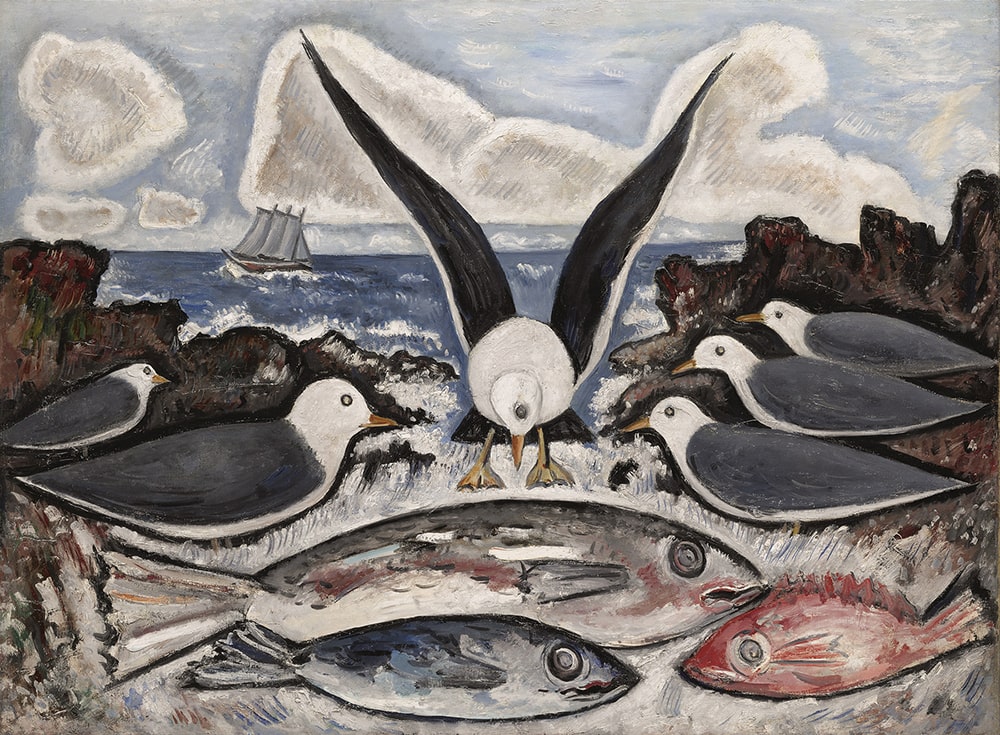Fairfield University Art Museum Announces
Birds of the Northeast: Gulls to Great Auks
The Fairfield University Art Museum announces an exhibition exploring environmental issues through avian art from the 19th-21st centuries. On view January 22, 2021 to May 14, 2021.
Media Contact: Susan Cipollaro, scipollaro@fairfield.edu, 203-254-4000 x2726
FAIRFIELD, Conn. (January 12, 2020) — Birds of the Northeast: Gulls to Great Auks features paintings, sculpture, prints, drawings, photographs, and natural history specimens from the early 19th century through the present day. Beyond merely connecting us to the natural world, the artworks in this exhibition remind us of the toll taken on bird habitats since the beginning of European colonialism in North America; the delicate ecosystems that allow birds of all species to thrive came under attack, as birds were hunted for food and ornamentation and their habitats were destroyed.
Curated by Museum Director Carey Weber and Fairfield University Biology professors Brian Walker, PhD, Jim Biardi, PhD, and Tod Osier, PhD, the exhibition complements the installation on Fairfield’s campus of The Lost Bird Project by artist Todd McGrain. These monumental sculptures, created as public memorials to North American birds driven to extinction in modern times, present a chronicle of humankind's impact on our changing world and a moving record of dwindling biodiversity (on view from October 2020 to August 2021).
The “lost birds” section of Birds of the Northeast: Gulls to Great Auks features studies for McGrain’s sculptures, a Great Auk skeleton lent by the Peabody Museum of Natural History at Yale University, and paintings of lost birds by contemporary artists including Walton Ford, Ann Craven, Morgan Bulkeley, and Alberto Rey.
The “living birds” section of the exhibition includes specimens of a variety of common, local birds, also coming from the Peabody. Highlights include Marsden Hartley’s Give Us This Day and Matthew Day Jackson’s portfolio There Will Come Soft Rains, which draws from numerous sources - including old Audubon copper plates - to explore both preservation and apocalyptic destruction. Additional artworks include works by Alexander Wilson, John Gould, Emily Eveleth, James Prosek, Rick Shaefer, Carolyn Blackwood, Christy Rupp, Christina Empedocles, and Paul Villinski.
“Some of these works were created specifically for this exhibition, which has been really exciting,” noted Weber. “It was wonderful to work with contemporary artists and see their enthusiasm for creating work in response to the environmentalist themes of this exhibition.”
Birds of the Northeast: Gulls to Great Auks celebrates local birds that we know well and continue to enjoy, while being reminded that worldwide, over 150 bird species have already been driven to extinction, and an estimated 1,200 more are estimated to follow over the next century if action is not taken. “One of the only links we have to the birds that have gone extinct are these images and sculptures,” noted co-curator, Dr. Brian Walker. “We should feel fortunate that the greater proportion of the work presented in this exhibition depicts birds we still have the opportunity to see in the wild. Here’s hoping we can keep them in that category.”
Wall labels and brochure texts, which will be bilingual (Spanish), coupled with virtual tours and programming will address how specific birds in the exhibition contribute to the ecosystem, the threats they face in their habitats, and the ongoing efforts to preserve these species and the ecosystems of which they are part. This unique interdisciplinary exhibition demonstrates the ways in which art and science can join forces to raise awareness not only of the importance of saving bird habitats, but the preservation of our broader natural environment. The museum is proud to partner with the Pequot Library, the Fairfield chapter of CT Audubon, and the Greenwich Audubon Center in presenting the programming for this exhibition.
A full range of programs have been planned in conjunction with this exhibition:
Thursday, January 21, 6 p.m.
Opening Night Virtual Lecture: Birds of the Northeast: Gulls to Great Auks
Brian Walker, Professor of Biology
www.thequicklive.com
Presented in partnership with the Department of Biology
Wednesday, February 10, 6 p.m.
Virtual Lecture: Marsden Hartley, Painter of Birds
Jonathan Weinberg, Artist and Professor, Yale University School of Art and Rhode Island School of Design
www.thequicklive.com
Part of the Edwin L. Weisl, Jr. Lectureships in Art History, funded by the Robert Lehman Foundation
Thursday, February 18, 11 a.m.
Art in Focus: Walton Ford, Dying Words, 2005, etching
Michelle DiMarzo, Curator of Education and Academic Engagement
www.thequicklive.com
Tuesday, March 2, 5 p.m.
Virtual Lecture: Birding While Black
Drew Lanham, Alumni Distinguished Professor of Wildlife Ecology, Master Teacher and Certified Wildlife Biologist, Clemson University
www.thequicklive.com
Presented in partnership with the Department of Biology
Tuesday, March 9, 5 p.m.
Virtual Workshop: Learn How to Draw a Bird
Suzanne Chamlin, Associate Professor of Studio Art, Department of Visual and Performing Arts
www.thequicklive.com
Tuesday, March 23, 4 p.m.
Virtual Lecture: Nature’s Best Hope
Douglas Tallamy, Professor of Entomology, University of Delaware
www.thequicklive.com
Presented in partnership with the Department of Biology
Wednesday, April 14, 5 p.m.
Virtual Lecture: Rara avis: John James Audubon: Artist, Naturalist, and Early Conservationist Roberta Olson, Curator, New-York Historical Society Professor of Art History Emerita, Wheaton College
Part of the Edwin L. Weisl, Jr. Lectureships in Art History, funded by the Robert Lehman Foundation
www.thequicklive.com

Image: Marsden Hartley (American, 1877 - 1943), Give Us This Day, 1938, oil on canvas.
Lent by Art Bridges
Posted On: January 12, 2021
Volume: 52 Number: 42
Fairfield University is a modern, Jesuit University, rooted in one of the world’s oldest intellectual and spiritual traditions. More than 5,000 undergraduate and graduate students from 36 states, 47 foreign countries, the District of Columbia and Puerto Rico are enrolled in the University’s five schools. In the spirit of rigorous and sympathetic inquiry into all dimensions of human experience, Fairfield welcomes students from diverse backgrounds to share ideas and engage in open conversations. The University is located in the heart of a region where the future takes shape, on a stunning campus on the Connecticut coast just an hour from New York City.